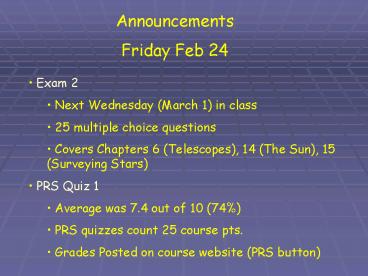Chapter 19 The Nature of the Stars PowerPoint PPT Presentation
1 / 27
Title: Chapter 19 The Nature of the Stars
1
Announcements Friday Feb 24
- Exam 2
- Next Wednesday (March 1) in class
- 25 multiple choice questions
- Covers Chapters 6 (Telescopes), 14 (The Sun), 15
(Surveying Stars) - PRS Quiz 1
- Average was 7.4 out of 10 (74)
- PRS quizzes count 25 course pts.
- Grades Posted on course website (PRS button)
2
Chapter 15 Topics
- Using parallax to determine far away are the
stars - The stellar magnitude scale
- Stellar spectra and colors
- The chemical composition of stars
- The HR diagram the key to understanding stellar
evolution - Properties giant, supergiant, and white dwarf
stars - Properties of binary star systems
- Estimates of Mass determination
- Spectroscopy evidence for binarity
- Eclipsing binaries precise mass determination
3
Equations needed for Chapter 15
- Parallax equation
- Luminosity ratio equation
4
Parallax nearby objects appear to shift with
respect to background as observer moves
5
Stellar Parallax As Earth moves from one side of
the Sun to the other, a nearby star will seem to
change its position relative to the distant
background stars. d 3.26 / p d distance to
nearby star in light years p parallax angle of
that star in arcseconds
6
(No Transcript)
7
Example Using parallax to determine distance
- The bright star Vega has a measured parallax of
0.1 arcsec (p0.1?) - This means that Vega appears to move from 0.1?
to -0.1? with respect to distant stars over a
years observation - D(pc) 3.26/p(?) 3.26 / 0.1 32.6 l.y.
- Vega is 32.6 light years from Earth
- But (Las) Vegas is only 1,500 miles from Iowa ?
8
- Note The brightness of a star is not a good
indicator of distance. - e.g., Polaris is closer than Betelgeuse but
Betelgeuse appears brighter.
9
Stellar magnitudes
- The apparent magnitude scale historically ranged
from 1 (brightest visuallu) to 6 (dimmest
visually). - Magnitude scale dates from Ptolemy (150 AD).
- Note that fainter objects have larger magnitudes!
- Today, the apparent magnitude scale extends into
the negative numbers for very bright objects
(Sirius, planets) and to 30 for the faintest
detectable objects (Hubble deep field). - Absolute magnitude, on the other hand, is how
bright a star would look if it were 10 pc away. - Absolute magnitude is a measure of luminosity
(wattage of the stellar light bulb). It is
independent of distance.
10
Apparent magniude scale
19 faintest object detectable using Iowas
Rigel telescope
11
Pleiades
12
Little Dipper (Ursa Minor) Guide to naked-eye
magnitudes
13
Q. A nearby star has an annual parallax of 0.5
arcsec. What is its distance?
- 0.5 light years
- 1.63 light years
- 2.00 light years
- 3.26 light years
- 6.52 light years
14
Q. Star A has a magnitude 10 while star B has a
magnitude -1. Which statement is correct for
visual observing these stars?
- Star A is very bright, Star B is faint
- Star A is faint, Star B is very bright
- Star A and Star B are both too faint to see
- Star A and Star B are both very bright
- Star A is too faint to see, Star B is very bright
15
Astronomy Picture of the DaySupernova 1987A
blast wave
Large Magellanic Cloud
Small Magellanic Cloud
16
Spectral Lines(fingerprints of elements and
molecules)
17
Importance of stellar spectra 1 Lines
determine what are stars made of (like
fingerprints)
18
The spectrum of a star-forming cloud
19
Importance of stellar spectra 2 Determine speed
of stars (and galaxies)
20
Solar Spectrum
Strongest lines Calcium!
21
The spectra of stars reveal their chemical
compositions as well as surface temperatures.
Element helium first seen on Sun (helios) then
found on Earth
22
Determining stellar surface temperature by
observing spectral lines
Sun
23
The spectra of stars reveal their chemical
compositions as well as surface temperatures.
- In the late 19th Century, spectra was obtained
for hundreds of thousands of stars. - These stellar spectra were grouped into a
(mistaken) classification scheme of spectral
types A through O by a team at Harvard.
- Today we recognize the spectral types O, B, A, F,
G, K, and M as running from hottest to coolest.
24
The Harvard College Observatory Women Astronomers
c.1910(they systematically classified stars
based on their spectra)
25
Spectral TypeCodes that indicates surface
temperature
- Sequence is O B A F G K M
- O type is hottest (25,000K), M type is coolest
(2500K) - Star Colors O blue to M red
- Sequence subdivided by attaching an integer, for
example F0, F1, F2, F3 F9 where F1 is hotter
than F3 . The Sun is a G2 star (5,800 K) - Useful mnemonics to remember OBAFGKM
- Our Best Astronomers Feel Good Knowing More
- Oh Boy, An F Grade Kills Me
- (Traditional, politically incorrect?!) Oh Be a
Fine Girl (or Guy), Kiss Me
26
Very faint
27
Q. Which spectral type has the hottest surface
temperature?
- B
- A
- F
- O
- M

